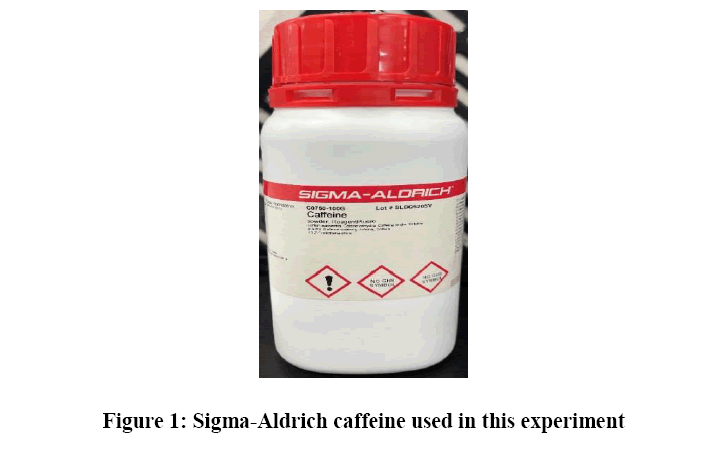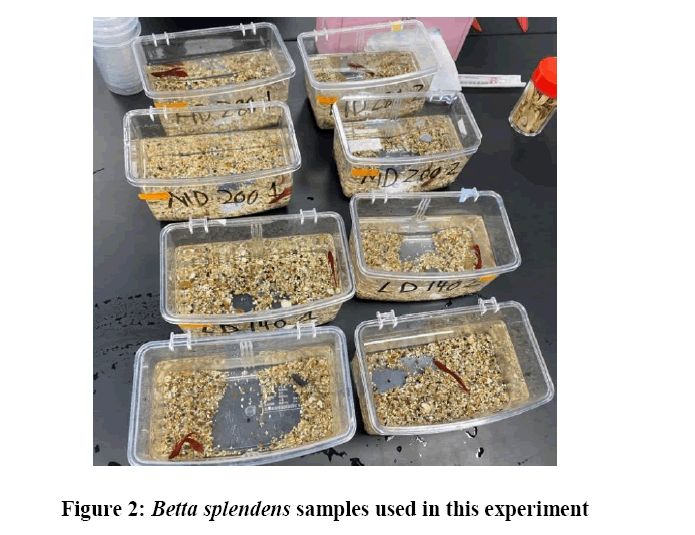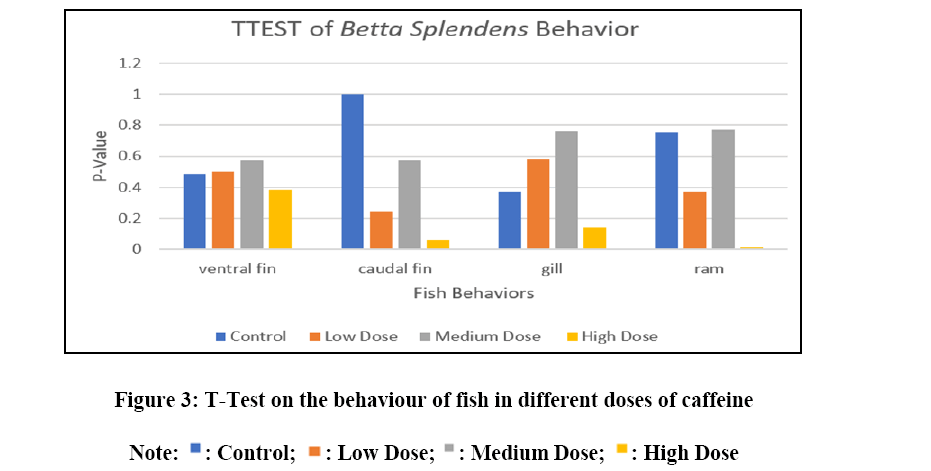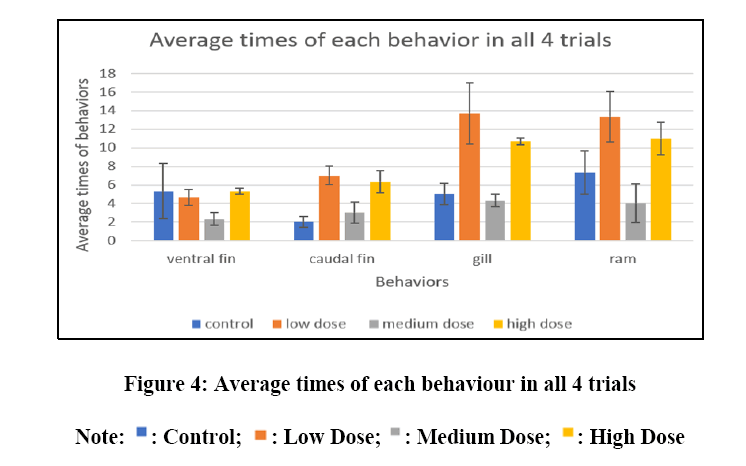Original Articles: 2022 Vol: 14 Issue: 10
Determining the Impact of Caffeine Concentrations on Betta splendens
- Corresponding Author:
- Andrew Lee
Department of Pharmacy,
Taipei American School,
Taipei,
Taiwan,
Republic of China
Received: 02-Nov-2022, Manuscript No. JOCPR-22-78850; Editor assigned: 07-Nov-2022, PreQC No. JOCPR-22-78850 (PQ); Reviewed: 22-Nov-2022, QC No. JOCPR-22-78850; Revised: 29-Nov-2022, Manuscript No. JOCPR-22-78850 (R); Published: 06-Dec-2022, DOI:10.37532/0975-7384.2022.14(9).018.
Abstract
Caffeine, a naturally occurring chemical stimulant called trimethylxanthine, is commonly consumed by humans through various products and is becoming more widespread. Consequently, caffeine has appeared in aquatic environments around the world. However, their safety for the health of humans and wildlife remains inconclusive. In this study, using Siamese fighting fish (Betta splendens), a fish known for its aggressiveness, we investigated the impact of varying caffeine concentrations on the aggressive behavior of the Betta splendens after seeing an intruder. There was four experimental caffeine used in the experiment: the control group without any caffeine added, another is the low dose (120 µg/L of caffeine), the medium dose (200 µg/L of caffeine), and the high dose (280 µg/L caffeine of caffeine). A T-test (using a significance level of 0.05) was used to determine the differences in behavior between the control fishes and the fishes with varying caffeine doses, which will allow us to evaluate the effects of caffeine on Betta splendens. The results showed that there is not much evidence to support the correlation between caffeine concentrations on male territory-holding and the increasingly aggressive behavior exhibited when an intruder is introduced. A better quantitative understanding of the anatomy of Betta splendens, such as the correlation between the biological systems of the fish responsible for aggressive behavior and caffeine, is needed to clarify the urgency of the issue of caffeine concentrations found in bodies of water worldwide.
Keywords
Caffeine; Betta splendens; Water quality; Aggression
Introduction
Caffeine is a natural stimulant most commonly found in tea, coffee, and cacao plants. Approximately 90 percent of all adults in the world consume caffeine daily [1]. Caffeine’s main effect on the human body is stimulating the brain to make one feel more energized and alert. Adenosine, a neurotransmitter that makes the human body feel tired, builds up as humans use energy throughout the day, which makes humans feel more tired as the day progresses. Consuming caffeine will intercept the effects of adenosine on one’s body, making one feel more energized. However, the human body does not metabolize and absorb all the caffeine ingested, as it is excreted by the body through bodily fluids and flushed into wastewater, which is filtered and recycled back into the environment [2,3].
As a result, caffeine has been found in waterways worldwide, especially in the United States of America and Switzerland. The maximum concentrations of caffeine in raw wastewater, treated wastewater, river, drinking water, groundwater, lake, catchment, reservoir, and rainwater samples were reported to be 3.60 mg/L, 55.5, 19.3, 3.39, 0.683, 174, 44.6, 4.87 and 5.40 µg/L, respectively [4]. Experiments have shown that the caffeine in the waterways had negative impacts on marine life (such as in algae, clams, and mussels) such as effects that lead to lower reproduction and growth rates. Eutrophication may also be triggered when caffeine ends up in waterways causing oxygen to decrease, ultimately impacts marine life [3]. Though, more research is needed to prove if lab experimentation on some fish species can be applied to the actual ocean environment with much different wildlife [5].
Thus, the subjects of this experiment are the Siamese fighting fish (Betta splendens). Betta splendens are freshwater fish often found in the marshes, ponds, or slow-moving streams of Southeast Asia and are available in pet stores worldwide, as male Betta splendens have a tendency to defend their territory from other fish [6]. Betta splendens are carnivorous animals who, in nature, primarily mostly consume insects and insect larvae near their surroundings. Male Betta splendens build bubble nests for their babies with their mouths and attract female Betta splendens to them. When the female begins to lay eggs, the male retrieves them and deposits them in the nest [7]. The males then chase the female away due to their inherent aggressive behaviors and guard the nest against intruders and predators until the eggs hatch. Male Betta splendens will exhibit very aggressive behavior against other fish, such as anal fin spreading, or attacking the opponent fish, as they act as territory-holders once they are used to their habitat [7]. If two male Betta splendens can see each other without an escape route, they will fight and, in some cases, die due to extreme fighting. Since these are characteristics common to Betta splendens, we can use these as indicators for changes in behavior due to the consumption of caffeine [7,8].
In this study, the effects of different caffeine concentration levels on male territory-holding Betta splendens on aggressive behavior of the fish will be explored by noting the number of ventral fin expansions, caudal fin expansions, rams against the tank wall, and the number of gill cover expansions.
Materails and Methods
Experimental Setup
In this experiment, sixteen Betta splendens (both intruders and territory holders) were obtained from a local fish shop. Eight will be territory holders and the other eight will be intruders. The Betta splendens will be isolated in their own individual water tank with opaque covers surrounding them to prevent them from being agitated due to the sight of other Betta splendens. The aggressive behavior is measured by measuring four characteristics: Operculum (Gill Cover) flair, Ventral (Pelvic) Fin flair, Caudal (Tail) Fin flair, and rams against the fish tank.
Construction of Experimental Groups -Sixteen transparent 1.5 L fish tanks were obtained from a local fish shop. The fish tanks were split into two groups: intruders and territory holders. All fish tanks were filled with 700 mL of water. The territory holders were grouped into four separate groups, with two fish in each group. One group will be the control group without any caffeine added, another is the low dose (120 µg/L of caffeine), the medium dose (200 µg/L of caffeine), and the high dose (280 µg/L caffeine of caffeine). On the other hand, all eight intruders were placed in water tanks without any added caffeine. All fishes were fed regularly in intervals of 8 hours with fish food.
Adding Caffeine to Experimental Groups-In this experiment, a Sigma-Aldrich caffeine container with a molecular weight of 194.19 g/mol was used to make the caffeine concentrations. We made a 2.5 L stock solution for caffeine of 0.02 g/L, then used proportions to find the amount of caffeine concentration per 0.700 L.
For the low dose group, we added 12 mL of caffeine stock solution into the 700 mL water; for the medium dose group, we added 20 mL of caffeine stock solution into the 700 mL water; for the high dose group, we added 28 mL of caffeine stock solution into the 700 mL water (Figure 1).
Conducting the Experiment-Before experimenting, we allowed the territory holder fish to rest (meaning they did not have any contact with other fish) for 24 hours in the water with each respective caffeine concentration. The intruders also rested for 24 hours with regular tap water (without added caffeine). After the resting period of 48 hours, we obtained a territory holder and an intruder fish and placed their fish tanks side by side so they could see each other. We observed their behaviors for a total of 5 minutes with 10 seconds in between recording the aggressive behaviors of the fish with a check mark, each indicating that the territory fish has exhibited a specific aggressive behavior. Each experimental group was repeated for two trials. After repeating this process for all four experimental groups, we used a t-test to see the differences in behavior between the control fishes and the fishes with varying caffeine doses (Figure 2).
Results
This graph is a t-test. A t-test shows whether there is a significant difference between the behaviors of fish in different doses of caffeine. We had three replicates (n=3) for each dose. The confidence level used in this experiment is 0.05, meaning if the t-test value is more than 0.05, it means there is no significant difference between the different types of trials. If the t-test value is less than 0.05, it means there is a substantial difference between the different types of trials (Figure 3).
Bars represent the mean results for three trials in each category (n=3) to test the number of times a specific behavior that the fish showed during the experiment when showed an intruder, ventral fin expansion, and caudal fin expansion, gill cover expansion, and rams to the tank. The legend represents the different behaviors the fish received in the experiment, the control with 0 µg/L dose, the low dose with 120 µg/L, the medium dose with 200 µg/L, and the high dose with 280 µg. Prior treatment of unimpeded habitat acclimatization lasted 48 hours. Error bars represent Standard Error (SE) (Figure 4).
Discussion
As seen in the t-test in Figure 1, most t-test values throughout the experiment were more than the significance level of 0.05, except for the high dose caudal fin expansions and rams against the tank when compared to their behavior without an intruder. This means that there is not much significant difference between the different types of trials. The Betta splendens with varying doses of caffeine exhibited similar behavior despite seeing another Betta splendens fish around its territory. In addition, as seen in Figure 2, there is no consistent pattern regarding the behaviors of the Betta splendens. For example, when the caffeine-dosed Betta splendens fish saw an intruder Betta splendens, there was no general pattern regarding whether the sampled fish will be more or less aggressive with more caffeine concentrated in their water. This indicates that across all experimental groups, caffeine consumption by the Betta splendens does not influence their behavior.
Nevertheless, one potential source of error in this experiment was when transitioning between different trials. The Betta splendens intruder fish did not rest for 24 hours as they were just used in the previous trials. As a result, the state of the Betta splendens intruders was not specific, and the fish possibly behaved more aggressively after seeing other Betta splendens fishes. In future experiments, the intruder fish should rest for 24 hours after every trial so that they can be in a calm state. In addition, a possible source of error was when conducting the experiments, the sounds of moving in a chair or banging the table with the legs would impact the state of the fish. As a result, the sampled fish will possibly panic and display abnormal behavior during the trials, which decreases the reliability of the data. A solution to solve this issue is to be gentler and more careful when sitting on chairs and tables when recording the data. Lastly, the concentration needed to be more consistent. After the first day of the experiment, the water with the caffeine concentration evaporated, and some caffeine was evaporated along the process. In future investigations with more time to conduct trials, experimenters should make new concentrations every trial to ensure the consistency of the water of each experimental group [9].
Conclusion
In summary, there is not much evidence to support the theory that caffeine concentrations in male territory-holding Betta splendens will make them exhibit more aggressive behavior when an intruder is visible compared to when it is in a calm state. Further research will be required to confirm this conclusion. Still, potential avenues of research are to better understand of the anatomy of Betta splendens and how it correlates with aggressive behavior when responding to caffeine. A possible implication of the current conclusion is that it can allow government and organizations to focus their efforts on removing other water contaminants from water rather than caffeine. This way, efforts can focus on eliminating more harmful contaminants from water, such as nitrogen, metals, and pesticides, on cleaning our waterways.
Author Contributions
The manuscript was written through the contributions of all authors. All authors have approved to the final version of the manuscript. These authors contributed equally.
Acknowledgments
Special thanks to Dr. John Heslar for demonstrating laboratory procedures and guidance in this research. Special thanks to Mr. Sean Tsao for helping with the orders of materials needed for this research. This scientific work uses the Taipei American School Science Laboratory, operated by the Department of Scientific Research.
References
- Peter A, Ruddy MS. J Nutr. 2016;17(8):180-1998.
- Cooper L. Probiotic Solutions. 2019.
- Moore V. Sustainable Business Toolkit. 2021.
- Li S, Wen J, He B, et al. Environ Pollut. 2020;263:114371.
- Li S, He B, Wang J, et al. Chemosphere. 2020;243:125343.
- Betta Fish: Facts and why they’re not ‘starter pets’ | PETA.
- Sturgeon, D. Betta splendens (Siamese Fighting Fish). Animal Diversity Web.
- The Fascinating origin of betta fish and other fun betta facts.
- US EPA, O. Types of drinking water contaminants. 2014.






